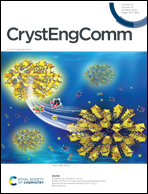Stoichiometry of adamantylamine–trinitrophloroglucinol salts controlled by solvate formation†
Abstract
The effect of the choice of crystallisation solvent on the stoichiometry of salts formed by a spherical base (adamantylamine, pKa = 10.7) and a planar triprotic acid (trinitrophloroglucinol, pKa1 < 0, pKa2 = 2.9, pKa3 = 6.5) was studied by dissolving a 3 : 1 mixture of the base and the acid in a series of 13 solvents. This has resulted in isolation of 10 distinct phases: a solvent free 1 : 1 salt, and nine solvates – two of 2 : 1 salts, one of a 5 : 2 salt and six solvates of 3 : 1 salts. With the exception of one 2 : 1 salt, all structures were layered with a hydrogen bonded network comprising anions, –NH3+ groups of the cations, and oxygen atoms or hydroxyl groups of the solvent molecules (if present) in the middle of the layer, and the hydrophobic adamantyl groups on either side. In solvates of the 3 : 1 salts with alcohols, these adamantyl groups form arrays of pentagons with remaining space filled by solvent molecules. This was observed only with smaller alcohols (MeOH, EtOH, trifluoroethanol and propanol) as well as water molecules, while larger alcohols lead to formation of the solvent free 1 : 1 salt. The structures of the 1 : 1 and 2 : 1 salts were found to be similar to those of equivalent adamantylammonium picrate and styphnate.



 Please wait while we load your content...
Please wait while we load your content...